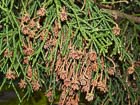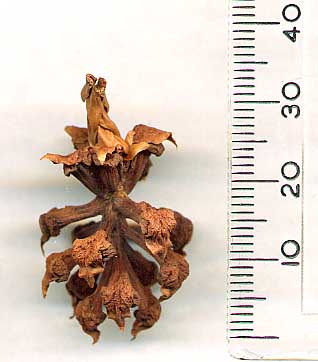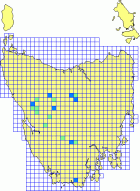
Foliage and cones on an ornamental specimen, Pinetum Blijdenstein, Netherlands [C. J. Earle, 2010.06.11].

Seed cone [M. Frankis, 2003].

Range map (Brown et al. 1983). You can also create a highly detailed map, and access specimen data, using the "search" function at the Australia Virtual Herbarium.

Conservation Status

Athrotaxis x laxifolia
Hooker 1843
Common names
Summit or yellow-twig Athrotaxis (Silba 1986).
Taxonomic notes
Syn: Athrotaxis doniana Henk. & Hochst. (Silba 1986). These trees are a hybrid of Athrotaxis cupressoides and Athrotaxis selaginoides; individual trees are only found in areas where both of the other species occur, display intermediate foliage characters; greenhouse studies have shown that the hybrids are fertile and will interbreed (Farjon 2010). Accordingly, it is here treated as a nothospecies, although it is not known if plants in habitat are primarily F1 hybrids or subsequent generations of hybrid parents.
Description
Monoecious tree with a conical, sparsely branched crown, 12-21 m. tall. Bark dark orange-brown, deeply fissured, flaky, exfoliating. Seasonal branchlets pale or bright yellow. Leaves ovate-lanceolate, slightly spreading, acute, 6 mm. long, with 2 white bands of stomata below, margins entire and translucent, apex incurved. Male cone with 2 pollen sacs. Female cone produced in pairs, densely clustered on ends of short shoots, ovoid, bright yellow or pale, 1.5-3 cm. wide, on a peduncle 2-3 mm. long; scales thin, triangular, papery, wavy, glaucous at the base, without prominent umbos. Seeds with 2 narrow wings (Silba 1986). See García Esteban et al. (2004) for a detailed characterization of the wood anatomy.
Distribution and Ecology
Australia: Tasmania: Mountain rainforests at elevations of 900 to 1200 m. The seeds are wind-dispersed (ANBG [no date]).
Remarkable Specimens
A maximum age of 1300 years is given by ANBG [no date], with no supporting data.
Ethnobotany
The timber is soft and pale red. It is not used commercially because the trees are not common and grow as isolated individuals (ANBG [no date]).
Observations
The species can be found, in general, wherever the parent species occur in close proximity (usually, within a few hundred meters of each other). I have seen it along the track between Dove Lake and Weindorfer's Pillar at Cradle Mountain National Park, and also at several locations along the Shelf Tarns track at Mount Field National Park. Both are easy dayhikes from a good road.
Remarks
The epithet laxifolia refers to the wider spacing of the leaves, compared to other Athrotaxis species, which makes the twigs easily bendable.
Citations
[ANBG] Australian National Botanic Gardens. [no date]. Australian Conifers. http://www.anbg.gov.au/anbg/conifers/">http://www.anbg.gov.au/anbg/conifers/, accessed 2002.11.09, now defunct.
Brown, M. J., J. B. Kirkpatrick and A. Moscal. 1983. An atlas of Tasmania's endemic flora. Hobart: Tasmania Conservation Trust. ISBN 0-9599816-8-3.
See also
Elwes and Henry 1906-1913 at the Biodiversity Heritage Library. This series of volumes, privately printed, provides some of the most engaging descriptions of conifers ever published. Although they only treat species cultivated in the U.K. and Ireland, and the taxonomy is a bit dated, still these accounts are thorough, treating such topics as species description, range, varieties, exceptionally old or tall specimens, remarkable trees, and cultivation. Despite being over a century old, they are generally accurate, and are illustrated with some remarkable photographs and lithographs.
Farjon (2005).



